The Unseen Price of Conflict: A Deep Dive into the Financial Cost of War
War isn't just fought on the battlefield it bankrupts nations, distorts global trade, and fuels defense giants. From Ukraine to Gaza, this analysis reveals the real, unseen financial toll conflict takes on the world.

The guns of war may roar on distant fronts, but their echoes reverberate through the global financial landscape. The ongoing conflicts in Ukraine and Gaza, distinct in their origins and immediate impacts, share a common thread: a significant and far-reaching financial cost. This cost extends beyond the immediate destruction and loss of life, deeply impacting national economies, international trade, and the very structure of defense industries worldwide. This data-driven analysis delves into the multifaceted financial implications of these conflicts, examining military spending, the impact of sanctions, and the broader economic ripple effects.
I. The Escalating Cost of Conflict: A Statistical Overview
Understanding the financial burden of war requires examining the direct expenditure on military operations and equipment.
A. Ukraine: A Nation Under Arms
The Russian invasion of Ukraine in February 2022 triggered a massive surge in military spending, both for Ukraine's defense and for the aid provided by its allies.
- 1. Ukrainian Defense Spending: Before the full-scale invasion, Ukraine's military expenditure was already on an upward trajectory. However, since February 2022, the need for weapons, ammunition, and logistical support has skyrocketed. Estimates from institutions like the Stockholm International Peace Research Institute (SIPRI) and the World Bank highlight the dramatic increase in Ukraine's military budget, often funded through international assistance. This expenditure includes not only immediate combat needs but also the long-term requirements of rebuilding and modernizing its armed forces.
- 2. International Aid and Military Support: Numerous countries have pledged and delivered substantial financial and military aid to Ukraine. This assistance ranges from direct financial injections to the provision of advanced weaponry, vehicles, and training. Tracking the precise value of this aid is complex, but various think tanks and government reports provide estimates running into tens of billions of dollars. This international support, while crucial for Ukraine's defense, represents a significant financial commitment for the donor nations, potentially diverting resources from other sectors.
B. Gaza: The Recurring Cycle of Conflict
The Israeli-Palestinian conflict, with its recurrent escalations in the Gaza Strip, imposes a significant financial burden on both sides, albeit with vastly different scales and resources.
- 1. Israeli Defense Expenditure: Israel maintains a consistently high level of military spending, a necessity it perceives due to the volatile regional security environment. Operations in Gaza, such as the conflicts in 2008-09, 2012, 2014, 2021, and the ongoing conflict initiated in 2023, lead to spikes in expenditure related to troop mobilization, missile defense systems (like the Iron Dome), and the costs of military operations. These repeated conflicts strain the Israeli budget and necessitate supplementary allocations.
- 2. Humanitarian Aid and Reconstruction in Gaza: The frequent conflicts in Gaza result in widespread destruction of infrastructure, housing, and essential services. This necessitates significant international humanitarian aid for immediate relief, as well as long-term reconstruction efforts. Organizations like the United Nations Relief and Works Agency for Palestine Refugees in the Near East (UNRWA) play a crucial role in providing this assistance, funded by international donations. The recurring nature of the conflict means that resources are repeatedly diverted towards reconstruction instead of sustainable development.
II. The Economic Fallout: Beyond Direct Military Spending
The financial cost of war extends far beyond the immediate military budgets, creating significant economic ripple effects.

A. Sanctions and Economic Disruption:
Sanctions imposed on belligerent nations are a key tool in international efforts to pressure them to cease hostilities. However, these sanctions also carry significant economic costs for the targeted countries and, to varying degrees, for the global economy.
- 1. Impact on Russia: Following the invasion of Ukraine, Russia has faced unprecedented international sanctions targeting its financial sector, energy exports, technology imports, and the assets of individuals and entities. These sanctions have led to a sharp contraction in the Russian economy, increased inflation, disruptions to supply chains, and limited access to international financial markets. While Russia has sought to mitigate these effects through alternative trade partners and domestic measures, the long-term economic consequences are substantial.
- 2. Global Energy Market Volatility: The war in Ukraine has had a significant impact on global energy markets. Sanctions and disruptions to supply chains have led to price volatility in oil and natural gas, impacting energy costs for consumers and businesses worldwide. This energy crisis has contributed to inflationary pressures and economic uncertainty across the globe.
- 3. Trade and Supply Chain Disruptions: Both the conflict in Ukraine and the situation in Gaza have disrupted international trade and supply chains. Ukraine is a major exporter of agricultural products, and the war has significantly impacted global food security. The ongoing tensions in the Middle East also pose risks to vital shipping lanes and energy transportation routes.
B. The Human Cost and Economic Productivity:
The most devastating cost of war is the loss of human life and the displacement of populations. These human tragedies also have significant economic consequences.
- 1. Loss of Human Capital: War leads to the loss of lives, injuries, and the forced displacement of people. This represents a significant loss of human capital, reducing the productive capacity of affected economies for years to come. The outflow of refugees, as seen in Ukraine, puts pressure on the economies of host countries while simultaneously depriving the home country of its workforce.
2. Healthcare and Social Welfare Costs: Conflicts lead to increased demands on healthcare systems, both for treating war-related injuries and for addressing the mental health consequences of trauma. Governments and international organizations also face increased costs for providing social welfare support to displaced populations and those affected by the conflict.

C. Reconstruction and Long-Term Economic Recovery:
The aftermath of war necessitates massive reconstruction efforts, a process that carries its own significant financial implications.
- 1. Infrastructure Damage and Rebuilding: Conflicts cause widespread damage to infrastructure, including roads, bridges, power grids, and communication networks. Rebuilding this infrastructure requires enormous financial investment and can take years, hindering economic recovery. The scale of destruction in Ukraine is particularly significant, suggesting a long and costly reconstruction process.
- 2. Economic Diversification and Resilience: Post-conflict economic recovery often requires diversification away from reliance on sectors directly affected by the war. Investing in new industries and building economic resilience is crucial for long-term stability, but it demands significant capital and strategic planning.
III. The Beneficiaries of Conflict: The Defense Economies
While war brings immense financial costs to many, it can also create significant economic opportunities for specific sectors, particularly the defense industries.

- A. Increased Demand for Military Hardware and Services: Ongoing conflicts directly translate into increased demand for weapons, ammunition, vehicles, and related military services. Defense contractors and manufacturers experience a surge in orders, leading to increased production, employment, and profits. The war in Ukraine has been a significant driver of this increased demand globally.
- B. Government Contracts and Investment in Defense: Governments facing heightened security threats or involved in conflicts tend to increase their defense budgets, allocating more funds for procurement, research, and development. This influx of government contracts provides a stable and lucrative revenue stream for defense companies.
- C. Technological Innovation in the Defense Sector: Warfare often spurs innovation in military technology. The need for more effective weapons, surveillance systems, and cyber capabilities drives investment in research and development, benefiting defense companies at the forefront of these advancements.
Conclusion:
The financial cost of war is a heavy burden, extending far beyond the immediate expenditures on military operations. The conflicts in Ukraine and Gaza serve as stark reminders of the devastating economic consequences, including disrupted trade, volatile energy markets, the loss of human capital, and the immense costs of reconstruction. While specific sectors, notably the defense industries, may experience economic gains, the overall impact on global economic stability and human well-being is profoundly negative. Understanding these intricate financial dynamics is crucial for policymakers and the international community as they strive to prevent future conflicts and mitigate the economic devastation they leave in their wake. The data clearly illustrates that the price of peace, while requiring diplomatic and political capital, is ultimately far less than the staggering and long-lasting financial cost of war.
For more legal exposes and truth-behind-glamour stories, subscribe to AllegedlyNewsNetwork.com




